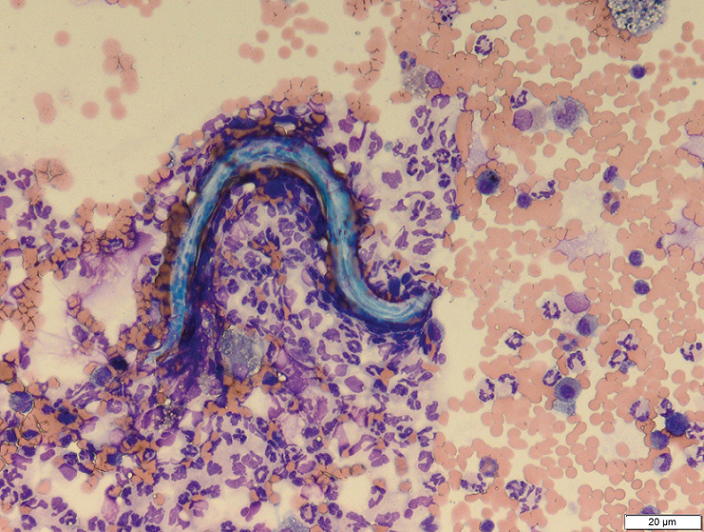Difference between revisions of "Canine Infectious Diseases: Self-Assessment Color Review, Q&A 08"
Jump to navigation
Jump to search
(No difference)
| |
Latest revision as of 09:43, 26 November 2018
| This question was provided by CRC Press. See more case-based flashcards |

|
Student tip: This case is an example of good cytology with a preventative medicine answer. |
Case 08 is the same dog as in Cases 06 and 07. Baermann fecal examination was negative. Cytologic examination of bronchoalveolar lavage fluid revealed larvae of Angiostrongylus vasorum (see image).
| Question | Answer | Article | |
| What treatment would you suggest for this dog? | In this dog, treatment should first stabilize the patient and then address the infection. For stabilization, the dog received intravenous fluids and two units of fresh frozen plasma for replenishment of coagulation factors. Three drugs can be used for treatment of canine angiostrongylosis: milbemycin oxime, moxidectin, or fenbendazole. The advantage of milbemycin oxime and moxidectin is that they can be administered less frequently than fenbendazole. However, in a study on naturally infected dogs, fenbendazole was as effective as moxidectin combined with imidacloprid. In the case described here, the dog was treated with fenbendazole (50 mg/kg PO for 14 days) (recommended dose: 25–50 mg/kg PO q24h for 7–21 days).
|
Link to Article | |
| What should you recommend to the owner to prevent reinfection? | To prevent recurrent infection in dogs living in endemic areas, owners should prevent their dogs from eating snails and slugs, which act as intermediate hosts for A. vasorum. Treatment in the prepatent period with milbemycin oxime or moxidectin can decrease the establishment of adult parasites and therefore can be recommended as prophylaxis for dogs that reside in endemic areas.
|
Link to Article | |
To purchase the full text with your 20% discount, go to the CRC Press Veterinary website and use code VET18.
